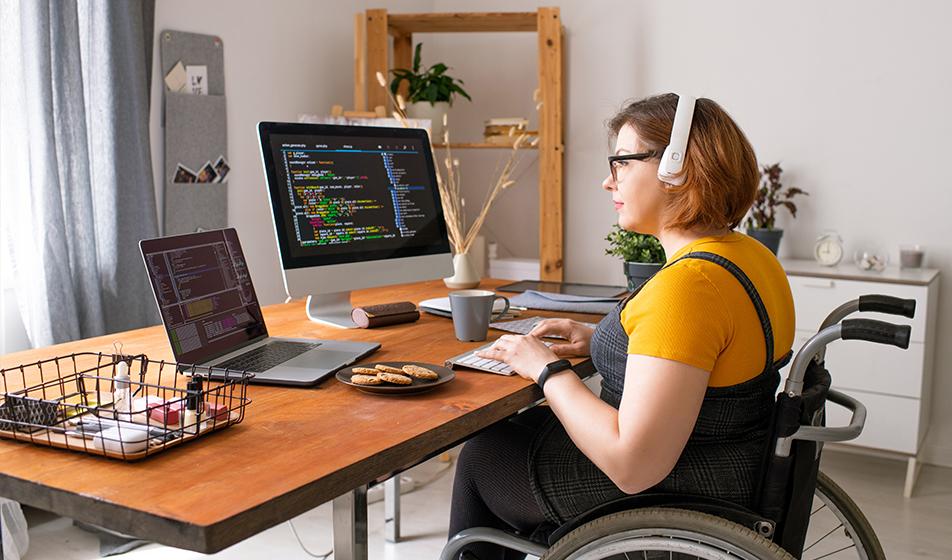In the post-pandemic world there will be fundamental differences to the way we live our lives. The ‘new normal’ will mean changes to the way we travel, socialise and the way we work. Before the outbreak only 32% of the population had ever worked from home, but now that’s changing.
With their hands forced, employers who were once hesitant about remote working are now feeling the benefits—and their employees are feeling it too.
However, not all employees want their home to be their permanent working base. There are a lot of benefits to be gained from office work, including collaboration, developing a company culture and in some cases a boost in productivity. In this case, a hybrid working model that allows workers to combine home and office attendance can be the answer.
What does ‘hybrid working’ mean?
Will hybrid working become the new normal?
How hybrid working fits into the future of work
What are the benefits of hybrid working?
What to consider when turning to hybrid working
Make the transition between office and home seamless
What does ‘hybrid working’ mean?
To put it simply, hybrid working is a flexible working model which allows employees to work from a variety of different locations. Its meaning can be found within its name - 'hybrid'. Think about hybrid cars. These combine both electric and traditional engines to create a vehicle which can seamlessly transition between the two. Similarly, hybrid working combines the option of working from home with the option to work in the office, or other public spaces.
The idea is a progression of flexible and fully remote working, created by a desire from employees to split more of their time between the home and office. The new trend towards hybrid working is largely the result of the Covid-19 pandemic, where many workers found themselves going into the office one or two days a week—if at all.
As a result, employers and employees were able to enjoy newfound autonomy, flexibility, improved performance and even new forms of collaboration. However, hybrid working is not an entirely new concept. This has been a growing trend over the past decade but has been accelerated in recent times.
Covid-19 and the changing workplace landscape
Covid-19 has been an undeniable driving force behind these changes. Many changes which experts expected to take place over the next decade have been fast tracked to accommodate the quickly changing needs of the working world.
The need for social distancing has forced many businesses, which did not previously consider remote working, to view it as a viable option. This has led to many companies restructuring their approach to make it work.
Even though employers and employees have enjoyed the benefits of working from home, the pandemic has also highlighted the mental and social need of workers. Many found that a couple of days in the office helped boost their mood, connect with their team members and collaborate company wide.
Covid-19 has forced employers to think about how to create balance between home and office work, and hybrid working is a great way for businesses to achieve that.
Will hybrid working become the new normal?
Does this trend towards balancing time between hybrid working from home and the office mean that hybrid working will become the new normal?
According to Xerox’s Future of Work Survey, on average, 82% of the workforce in the 600 organisations they researched will be back in their workspace in 12-18 months.
However, even though many are likely to return, most companies will be increasing their technology and digital budgets to develop and support hybrid working.
Research collected by the Chartered Institute of personnel and Development (CIPD) backs this evidence, indicating that in the UK employers expect their proportion of home workers to double. There is also evidence that in the US 55% of workers want a mixture of home and office working too.
These findings suggest that many companies are ready to adapt and embrace hybrid working as part of the changing working landscape. The question then is: what will hybrid working actually look like going forward?

How hybrid working fits into the future of work
In the case of orientations, team building and project kick-offs, an in-office presence will still be required for most companies. However, this may not be the case for other work. Some have found that tasks that would once take up much of the day, can be completed quickly at home.
Free from the distractions, socialising, ad-hoc requests and the general hum of the office, people are finding out they can get a lot more done.
With this in mind, office spaces can change. Instead of rows of desks or cubicles, more breakout areas can be created to be used purely for collaboration. Some companies may even think of downsizing their office when there is no need to accommodate large numbers of people.
A reduced office presence will likely then have a knock-on effect on company structure. With a smaller on-site presence, businesses can afford to invest in larger teams. Plus, without the need for an on-site presence, companies can spread their net wider to hire from different socioeconomic backgrounds and locations.
What are the benefits of hybrid working?
The potential to hire from a wider talent pool is just one of the many benefits of hybrid working. In fact, there are two core benefits of hybrid working to keep in mind.
Increasing productivity
Most work on a computer can be done anywhere and some feel that when they are free from office distractions they work at their best. However, this is not always the case. An individual's productivity can be affected in different ways. For every person who works well from home, another may need the office to be able achieve the results they want.
Although an office may be full of distractions, being at home can be just as distracting. Home working employees may not have an effective workspace or a strong enough internet connection, for example. Alongside this, employees at home can start to feel siloed, lonely, and out of sync with their colleagues. Put one or more of these together, and you're going to see a drop in the productivity of some of your employees.
A flexible working arrangement such as hybrid working can help bridge that gap. With the option to work from home or go into the office at will, the needs of both can be met.
Job satisfaction and wellbeing
Alongside having a positive effect on productivity, having a sense of freedom about where they work can help increase an employee’s job satisfaction.
With the ability to work from where they choose, employees feel as though they have more control of their working schedule and home life.
This control can range from being able to go to the gym at lunch to picking up a child from school. It could even empower your employees to see a loved one during visiting hours at a care home or hospital.
Offering this type of flexibility through hybrid working can result in an increase in employee happiness, improved wellbeing, reduced staff turnover and a more driven workforce.
Better collaboration and working relationships
It’s no secret that in-person, office-based working and its face-to-face interactions makes collaborating easier. It promotes employee engagement with their colleagues, allows them to chat during breaks and share useful ideas.
While some remote working tools do allow employees to interact, the interaction is not the same as those they would have in an office. By incorporating a hybrid working model, staff can get the best of both. Employees can innovate together and develop personal relationships, while also being able to work remotely when deep concentration is required.
What to consider when turning to hybrid working
Before making the switch to a hybrid working model there are some key considerations to take into ask yourself:
Are you able to trust your employees?
A large part of the success of a hybrid working model will be the employer’s ability to trust their employees.
Firstly, employers will need to be able to trust that their employees will complete their work. However, this is a concept that works both ways. Employees will also need to trust employers to keep them protected, allowing them to manage their workload in a way which suits them between the home and office.
Clearly define what hybrid working means for your workforce
As an employer you should clearly define what hybrid working is in regard to your organisation.
Outline if there any spaces that aren't suitable for hybrid working and if there are any core hours. Also explain what is expected of your employees in regard to flexible working. Discuss how they should behave, communicate and what you as an employer will provide in return. This can be done with a specific hybrid working policy, as part of the staff handbook.
Figure out how to communicate
Knowing how your company will communicate is essential to the successful implementation of hybrid working. When this is not organised correctly it can have a damaging effect on your business. The consequences can range from poor information flow and knowledge gaps to blockers between those working in and outside the office.
As an employer, make sure you provide your staff with the right tools for communication. Exactly what you need will be determined by the size of your business. Smaller organisations will need less sophisticated tech as there will be less people to keep track of. Larger organisations will need something more comprehensive.
To keep communication effective, try these tips:
- Keep all meetings online as default: This will help keep things consistent
- Allow team members to establish their own lines of communication: Trust employees to find ways of communicating, but also provide a basic structure to work around.
- Make use of ‘chat’ tools: Slack, Google Chat, Or the chat function in Microsoft Teams can all promote casual conversation and collaboration.
Be aware of wellbeing and mental health
Without regular access to your staff and the potential isolation of working from home, being attentive to the needs of your employee’s mental health will never be more important.
You can help you employees by:
- Providing ongoing mental health support for all staff
- Offering training on work-life balance and digital wellbeing: This can help promote healthy habits for technology usage, helping them disconnect from work.
- Help managers with mental health and wellbeing training: This will help them understand all the wellbeing implications of hybrid working. It also ensures they are aware of the signs of poor wellbeing and mental health.
- Implement a good mental health and wellbeing policy
Make the transition between office and home seamless
Keep track of employee absences, manage holiday requests and store all your important HR documents from the office or at home. Breathe’s easy-to-use online system will help you free up time for what’s important—helping you manage your employees in a way that integrates seamlessly with the new frontier of flexible, hybrid working.
Author: Andy Stewart
 (1) (1).webp)




